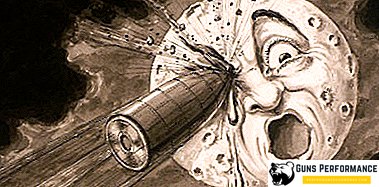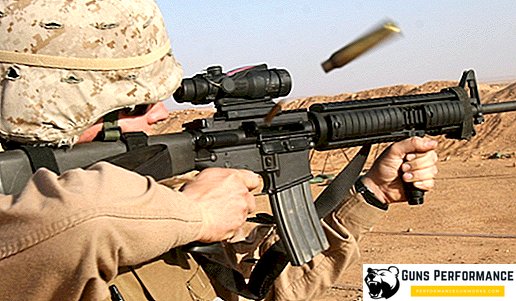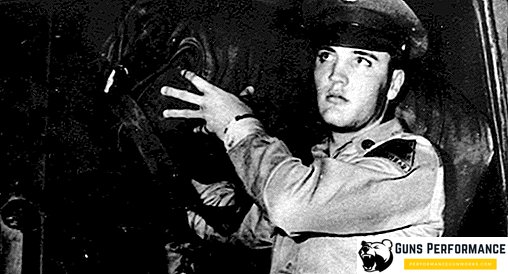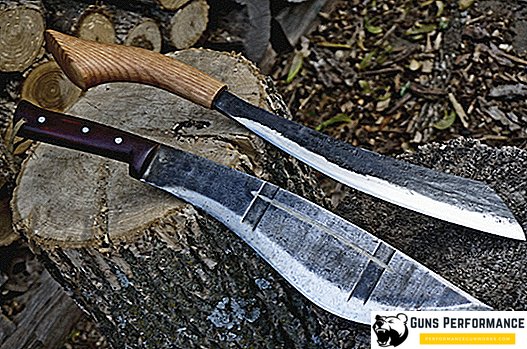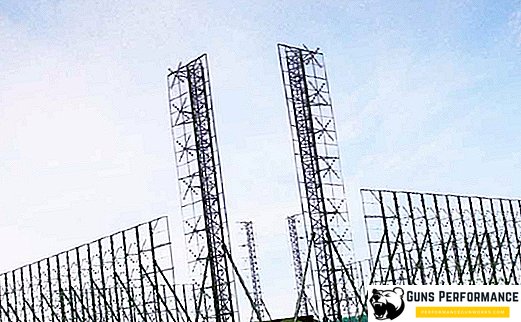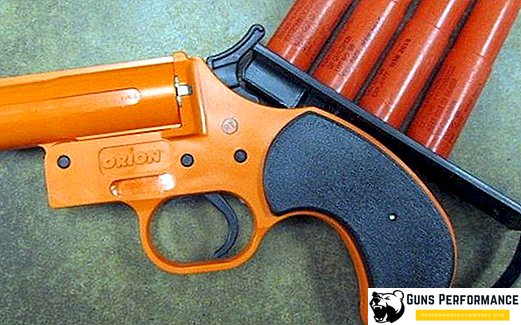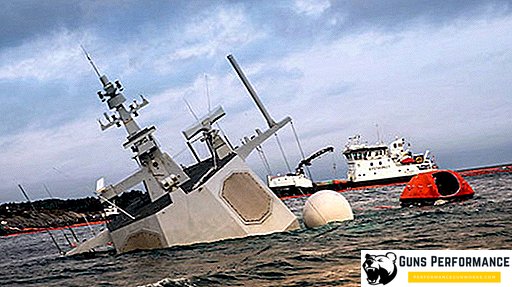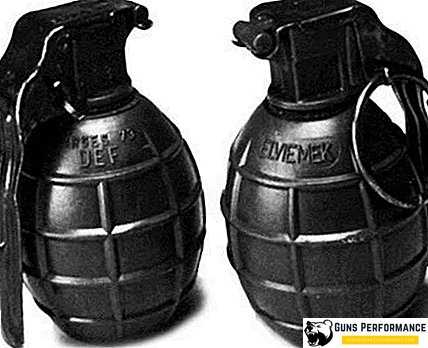A carabiner is a modification of a rifle, with a shortened barrel and lighter weight. Originally, these small arms were designed to equip cavalry. Carabiners can be either automatic or manual recharge. The most famous carbine, created in the Soviet Union, is the SKS - Simonov's self-loading carbine. The development of this weapon began during the war, and for more than seven decades this peer of Victory has been in service with the Soviet and Russian army.

In addition, the Simonov carbine is one of the most popular and recognizable types of hunting weapons. Simplicity, "indestructibility", undemanding to the quality of ammunition and high accuracy made this weapon a favorite, not only among amateur hunters, but also professional hunters. These qualities have led to the fact that the SCS is still actively used in local conflicts, the carbine is especially popular with all sorts of partisan formations.
There is another curious function that the SKS carbine has been performing for many decades. If you attend the ceremony of changing the guard of honor in Moscow, you can see: the soldiers of the Presidential Regiment are armed with SKS carbines. The harsh beauty of this weapon perfectly complements the unique coherence of the fighters' movements, their combat step, perfected to perfection.
The SKS carbine is one of the most popular types of ceremonial weapons, and not only in Russia. Similarly, it is used in most CIS countries and in China.
In the international classification, this weapon is usually called the SCS-45, although it was adopted for use several years later.
A bit of history
The development of the SKS carbine began in 1943, the impetus for this was the completion in the USSR of work on the intermediate cartridge. The emergence of this ammunition can be called one of the most important events in the history of small arms of the last century.
Already after the end of the First World War, it became clear that both rifle and pistol cartridges have their drawbacks. The rifle cartridge was powerful, it had high accuracy and excellent range of fire - but these advantages were leveled by a large mass of weapons, limited ammunition, which the fighter could carry with them. The firing range of the rifle cartridge reached two kilometers and was clearly excessive: the aimed fire at the enemy was usually conducted from a distance of up to 400-500 meters. In addition, under the rifle cartridge is extremely difficult to create an effective automatic weapon.

The pistol cartridge had insufficient power and ensured a range of effective fire at a distance not exceeding two hundred meters. This was clearly not enough.
It was necessary to create a medium-power ammunition, intermediate compared to rifle and pistol cartridges. In many countries, development in this direction began, and the Germans were the most successful in this field: as early as 1940, Polte created the first serial intermediate cartridge 8 × 33 PP Kurz (7.92 × 33 mm), which will then be used for the famous automatic STG-44.
In the USSR, such works were actively started only in 1943 after studying German trophy samples, as well as acquaintance with the American M1 carbine.
Soviet designers were instructed to develop a family of weapons for an intermediate cartridge: a magazine rifle, a self-loading carbine, an automatic rifle, and a light machine gun. The Germans had a slightly different strategy: they sought to create a universal weapon for an intermediate ammunition - an assault rifle (SturmGewehr).

In 1943, the Soviet intermediate cartridge of 7.62 × 39 mm, developed by Elizarov and Semin, was adopted. And at the end of 1944, under the leadership of designer Simonov, the first samples of a self-loading carbine for this ammunition were created. Creating a new weapon in such a short period is explained very simply - the carbine that Simonov had already offered at the competition in 1940 was taken as the basis. In addition, when creating the SCS, experience gained from operating an ABC-36 rifle was used.
A small batch of a new rifle was manufactured, in early 1945 it was sent to active forces, to the Belorussian front. The soldiers liked the weapon, the carbine received positive reviews, but its refinement (as well as the refinement of the new ammunition) continued until the beginning of 1949. Only then he was put into service under the name "Simonov's self-loading carbine, model of 1945" (SKS-45).
For several decades, the Soviet army was armed with three models of small arms, created under the intermediate cartridge: SKS-45, AK-47 and Degtyarev machine gun. It was believed that they complement each other: the Kalashnikov assault rifle allowed to conduct effective fire for short distances and create a greater density of fire. The SKS-45 could precisely work at longer distances, as it had a longer barrel and an aiming line. Gradually, AK began to force out self-loading carbines, but in some types of troops (air defense, communications), these weapons were used until the end of the 1980s.
Like many other types of weapons made in the USSR, the SKS-45 was actively supplied to the countries of the socialist camp and to the states that were considered allies of the Soviet regime. In many countries, the Simonov self-loading carbine was produced under a license: in China, the GDR, Yugoslavia, Albania, Egypt, the United Arab Emirates.

During its long history, the SCS-45 managed to participate in a large number of Cold War military conflicts in various parts of the world. The Korean War was the first serious baptism of these weapons, where it showed itself from the best side. The next large-scale conflict in which the carbine was widely used was the Vietnam War. The SCS-45 performed well in the difficult conditions of the jungle. This carbine armed the most combat-ready units of the Vietnamese army.
Using the SCS-45 in Vietnam led to another interesting result. The Americans took a huge number of captured Simonov carbines from this country. Currently, due to its simplicity, reliability, low cost and high performance, this weapon is one of the most popular in the United States. Today, it is the American arms market that is the largest consumer of the SKS-45. The number of SCSs sold in the USA is in the millions. A significant number of American weapons companies are engaged in the upgrade of these weapons.
After the SCS in the army was replaced with Kalashnikov assault rifles, these carbines were increasingly offered to the hunting industry, to various geological expeditions.
This weapon is very popular with hunting enthusiasts due to its excellent qualities: unpretentiousness, reliability, excellent technical characteristics and affordable price (SCS is one of the cheapest carbines of a similar class in the world). It works perfectly in a large temperature range, more than once visited expeditions to the North Pole and never failed travelers.
Currently, a large number of SCS is still mothballed in military depots in almost all former republics of the USSR. There is a fair amount of companies involved in the conversion of these weapons into civilian modifications, especially since the difference between hunting weapons and combat weapons is insignificant. On the basis of the SCS, smooth-bore carbines were developed (for example, “Vepr”).
It is believed that since the time of putting into service more than 15 million Simonov carbines were fired. But if we take into account the number of illegal manufacturers of SCS and its modifications, to be completely confident in this figure is impossible.

Simonov carbine device
Automatic SKS works on the principle of removal of powder gases from the barrel. Unlike the device of the Kalashnikov assault rifle, the SKS gas piston acts on the bolt carrier with a bolt through a special pusher. Simonov's carbine consists of the following parts:
- barrel with receiver;
- gas tube with a special lining;
- gas piston;
- receiver cover;
- spring pusher;
- return mechanism;
- gate;
- trigger mechanism;
- bed;
- score.
At the moment of firing, gases pass through a hole in the barrel bore and push the gas piston back. It acts on the pusher, which moves the bolt back and opens the barrel. The recoil spring is compressed, and the trigger is cocked, and the sleeve is removed from the chamber.
During the forward stroke, the cartridge is sent to the chamber. After the ammunition is used up, the bolt becomes a slide delay.
Sighting devices SKS-45 consist of a front sight and a sight. The sight consists of a strap, pad and lug. The aiming level has gradation from 1 to 10, each of divisions designates hundred meters.

The power supply of the weapon comes from an integral shop. The location of the cartridges - chess. To install the cage in the bolt carrier made special guides.
Trigger trigger type. The weapon's guard blocks the trigger.
The stock and butt form a whole, made of birch or stamped plywood.
Combat samples SKS were equipped with an integral bayonet, which was formed back. The first SKS carbines had a needle bayonet, then a blade-shaped bayonet was adopted, which became a characteristic sign of the SKS carbine.
It should be noted that the SKS carbine does not have a single screw in its design; all the details of the weapon (except for the case and the lid of the magazine) are made by milling.
Modifications
The hunting version of the carbine differs very little from the army version. Differences can only be detected at close range or by taking a weapon in hand. A carbine designed for hunters does not have a bayonet mount (and the bayonet itself, respectively), the aiming strip is shortened to 300 meters, and a pin is added to the barrel.
There are no more differences between the SKS-45 and the OP-SKS (the so-called hunting carbine).
Today there are the following modifications of this weapon:
- OP-SCS - SCS, converted at the Tula Arms Plant or the company "Hammer" of military weapons. There is no fastening under the bayonet, the aiming strip is shortened, the pin is installed in the barrel.
- TO3-97 "Arkhar" - also a modification of gunsmiths TOZ. Mounts for an optical sight are installed on it, the shape of the bed is somewhat changed.
- KO SKS (hunting carbine) is a modification of TsKIB SOO.
- NPO "Fort" produces two modifications of this carbine: SKS-MF (SKS without a bayonet) and "Fort-207" (SCS with a modified forend and plastic butt).
On the basis of the SKS carbine, a smooth-bore carbine Vepr VPO-208 was also developed. It should be noted that reviews of the alteration of the SCS in a smooth-bore weapon are rather ambiguous.

Advantages and disadvantages
Benefits:
- Multi-charge. This is very important, especially during the hunt for a large animal.
- Reliability. Most of the details of the weapon are milled, the life of the barrel ranges from 15 to 25 thousand shots
- Cost SKS - one of the cheapest samples of such weapons in the world.
Disadvantages:
- Ergonomics carbine designed for the average soldier 50s of the last century. His height was about 165 cm. If your height is much larger, then use the carbine will not be so convenient
- Extraction sleeve up. Some gun owners criticize the carbine feature.
- Insufficient power of the cartridge 7,62х39 mm. This gripe is most common. Especially a lot of complaints about its weak stopping effect. It is believed that this cartridge is not very effective against big game. But for many professionals, this view seems controversial. Rather, we can talk about the insufficient stopping power of the standard bullet (and not the cartridge). To fix this flaw is easy: when hunting for big game you should use expansive bullets, which almost completely solves this problem.
Another problem that the owners of these weapons very often draw attention to is that army carbines with a partially worn barrel are often used for rework, which negatively affects the characteristics of the weapon.
Before buying a carbine, it is recommended to pay attention to the state of the barrel (you should measure the caliber).
Anyway, the acquisition of the SKS carbine is the cherished dream of any hunting enthusiast. It can be called the favorite weapon of several generations of hunters, foresters, geologists.
Specifications
| Caliber, mm | 7,62 |
| Applicable cartridge | 7.62x39 |
| Length without bayonet, mm | 1020 |
| Barrel length, mm | 520 |
| Weight without cartridges, kg | 3,75 |
| Magazine capacity, cartridges | 10 |
| Sighting range, m | 1000 |
| Rate of fire, shots / min | 30-40 |


